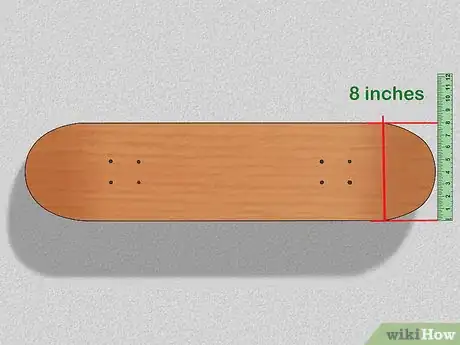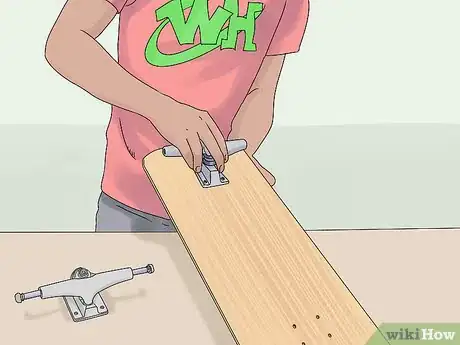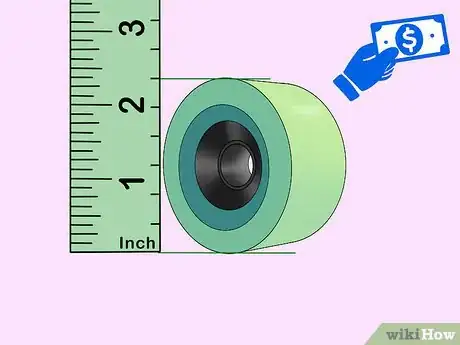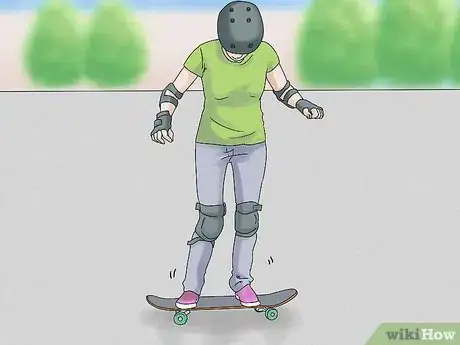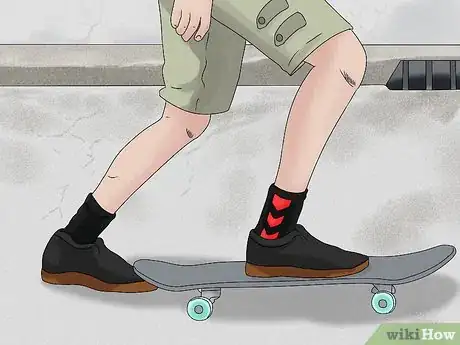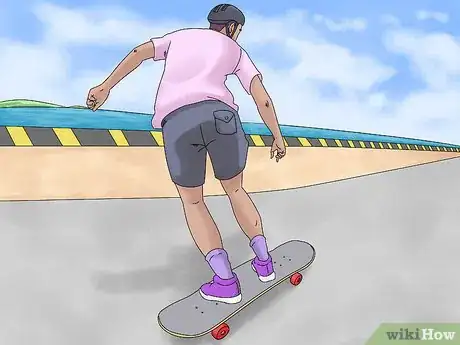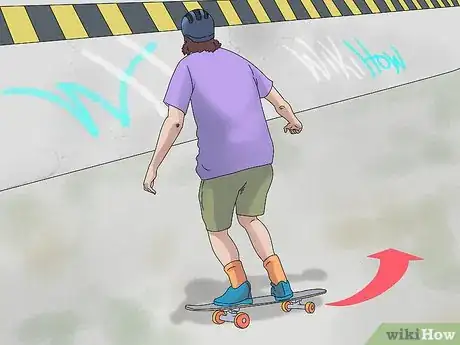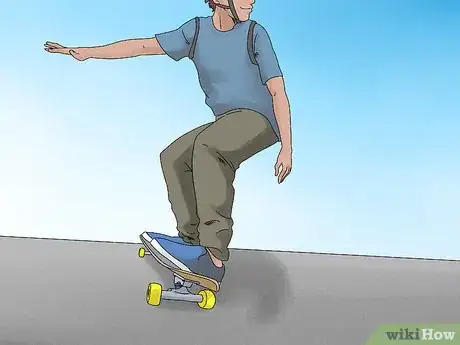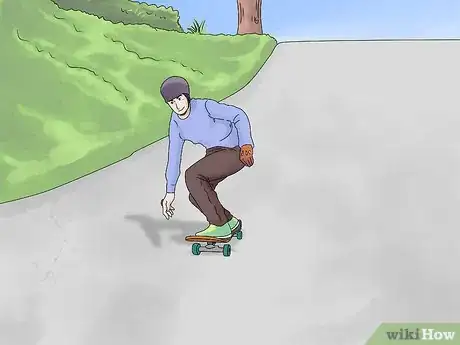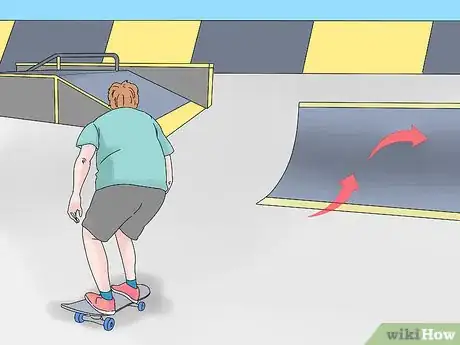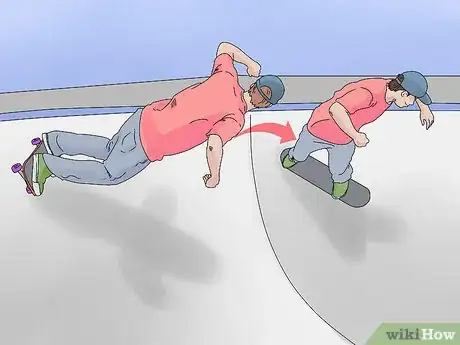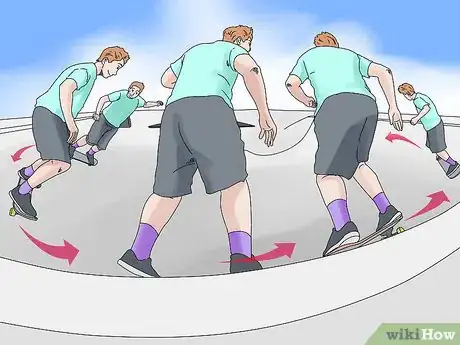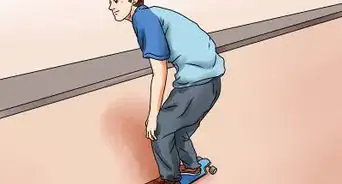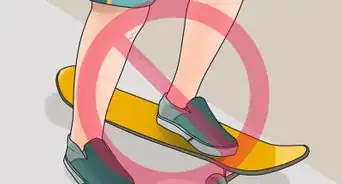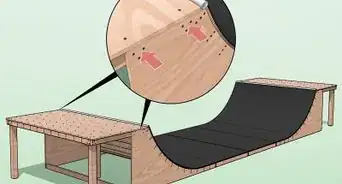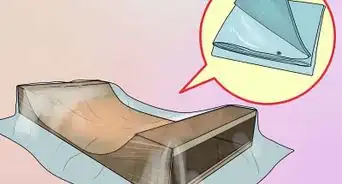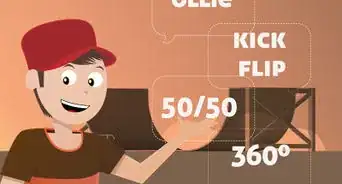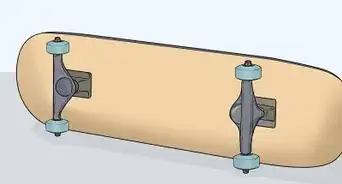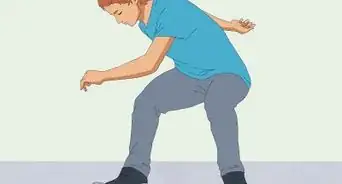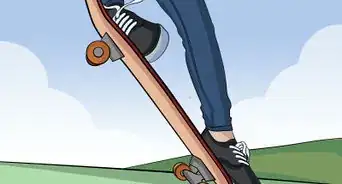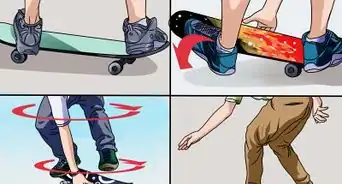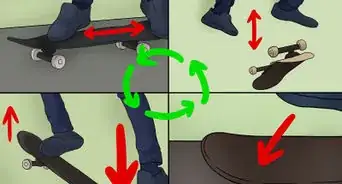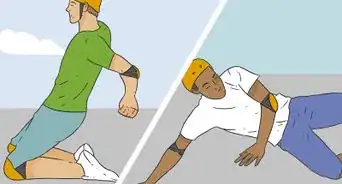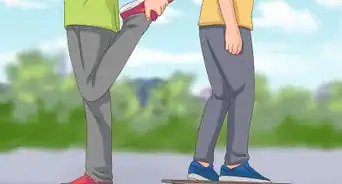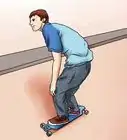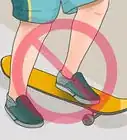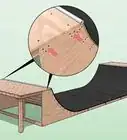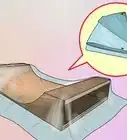This article was co-authored by wikiHow Staff. Our trained team of editors and researchers validate articles for accuracy and comprehensiveness. wikiHow's Content Management Team carefully monitors the work from our editorial staff to ensure that each article is backed by trusted research and meets our high quality standards.
This article has been viewed 28,379 times.
Learn more...
Whether you're speeding downhill, cruising the streets, or doing some vertical skating, carving is a crucial technique that stabilizes your board and maintains speed. Although most commonly used by longboarders, all kinds of skaters can benefit from carving. To learn how to carve, you need to have the right skateboard and understand the basic techniques. Once you get these steps down, you can move on to advanced carving techniques.
Steps
Getting the Right Skateboard
-
1Purchase a skateboard with a width of at least 8 inches (20 cm). Whether you buy a pre-assembled board or create your own, your deck's width should be between 8 to 8.25 inches (20.3 to 21.0 cm). This width is best if you're going to be carving in parks, on ramps, or in skating pools.[1]
- If you're going to be skating vertical or doing lots of long-distance skating and trails, purchase a deck 8.25 inches (21.0 cm) wide or higher. This kind of deck is also great for old-school, flat-ground skateboarding tricks, like pogos, caspers, and street plants.
-
2Attach trucks at least 8 inches (20 cm) wide. In general, your truck axle should have a width that is close to the width of your skateboard deck. For 8 to 8.5 inch (20 to 22 cm) skateboard decks, use an 8 inch (20 cm) truck axle. If your deck is between 8.5 to 9 inches (22 to 23 cm), use an 8.5 inch (22 cm) truck axle.[2]
- If you have a 9 to 10 inch (23 to 25 cm) skateboard deck, a 9 inch (23 cm) truck axle is ideal.
- If you have a skateboard deck 10 inches (25 cm) wide or more, use a 10 inch (25 cm) truck axle.
- Medium and high truck profiles (the distance between the bottom of your deck and the triangular hangers that hold your wheels) are best for carving.
- Keep your trucks loose for easier carving.
Advertisement -
3Invest in wheels at least 2.12 inches (54 mm) in diameter. Wheels between 2.12 to 2.32 inches (54 to 59 mm) in diameter are best for carving bowls, skate parks, and vertical ramps. If you're doing exclusively downhill skating and cruising, your wheels should be at least 2.36 inches (60 mm).[3]
- Always go for larger wheels—they are better suited for rough surfaces and extended skating (longboard wheels are always larger for this reason).
- In terms of hardness, wheels that are 96a to 99a are best for beginners that are skating pools, ramps, streets, and skate parks. Although 101a hardness wheels are the fastest and hardest, they are designed for professionals and not recommended for beginners.
Learning Basic Carving Techniques
-
1Find your balance when stationary. Wedge your wheels into a crevice to hold your wheels in place. Get onto the board in a standing position. With your knees bent, use the tips of your feet to rock back and forth without lifting your wheels off the ground.[4]
- Don't practice carving until you're comfortable balancing on your skateboard without moving.
-
2Practice pushing on a flat surface. Pushing is the technique that helps you get the speed necessary to carve. Take one foot off the board, and push it against the pavement while your other foot stays in place. Most people push with their dominant foot. Keep your eyes up, not down, to control your direction.[5]
- Keep about 1 foot (0.30 m) between your kicking foot and your board when pushing. If your foot is too close to your board, you might kick your wheel and fall.
-
3Pick a line to travel. Before you begin carving, you need to decide on your route. Once you start carving, focus on always returning to the line. Sticking to your line is the key to mastering this technique.[6]
- Different paths will give you different speeds. Keep an eye on other skaters and take note of the carving paths they use. For example, longer paths require higher speeds and a stronger push before the carve.
-
4Practice turning inwards (also known as a frontside carve). Gain some forward momentum on a flat surface. Push down on your board with your toes and lean forward slightly with your chest, keeping your arms to your sides. To steer movement, turn your shoulders inwards. [7] .
- Stand back up straight after you finish carving.
-
5Practice turning outwards (also known as a backside carve). Push forward on a flat surface. Just before carving, bend your knees and push down on your board with your heels. Lean back slightly with your chest and buttocks, as if you're going to sit in an armchair. Extend your arms out to the sides.[8]
- Use your shoulders to steer your movement and guide your body
- Once you have completed the carve, return to the standing position.
-
6Skate downhill at a moderately fast speed. Bend your knees and keep balance. You can bend down as far as you feel comfortable, even to the point where you are almost sitting on the board. Practice both frontside and backside carves.
- When you reach the bottom of the hill or want to stop carving, stand up and slow down.
- You can also use foot-braking, or slide with a pair of specialized gloves.
Practicing Advanced Carving Techniques
-
1Skate along a transitioned (curved) halfpipe wall. Pick a line that gives you enough space to ride in an arc shape. Roll into the arc at a good speed, and push yourself into the transitioned wall to give yourself a good speed boost. Keep your knees bent and don’t lift your wheels – this will stop the carve by ruining your momentum.[9]
- If you find you can't travel the entire arc, push into the line with more speed. The speed that you enter the carve with must be enough to hold you to the wall for the duration of your arc.
- Hold your position until you begin rolling in the opposite direction as the wall. At this point, slowly stand up and return to a neutral position.
-
2Carve the corner of a bowl. Set your line based on the carve you want. For example, if you want to gain a lot of speed, pick a line that begins low on the corner but high up on the side wall of the bowl – when you come back down, you'll get a big speed burst. If you carve high up on the corner and low on the bowl's walls, you'll need lots of speed, but you will maintain this speed.[10]
- To carve high on the corner of a bowl, you'll need a lot of speed. Be sure to give yourself a nice push before you hit your line.
-
3Practice carving long curves. If you want to carve a big curve or long pocket in a bowl, you need to push into it with lots of speed. This is essentially like carving the side of a halfpipe, only for a much longer duration. Give yourself a couple of pushes before hitting your line and keep your knees bent.
- If you feel yourself falling away from the curve too soon, turn away from the wall, leave your line, and start over. Next time, hit the line with a higher speed.
- Be patient and keep practicing when carving long curves. If you're having trouble getting and maintaining speed, try approaching your line differently. For example, try hitting your line sooner or later to gauge the best approach.
Community Q&A
-
QuestionHow can I prevent being scar or fall?
 gabriella perezCommunity AnswerGetting some practice is key. You also need to keep in mind that you are gonna fall and that's okay. People who have been skating for a long time fall too. When your riding, just try and enjoy your ride, and trust your board. Give the board a name if that's going to help with trust.
gabriella perezCommunity AnswerGetting some practice is key. You also need to keep in mind that you are gonna fall and that's okay. People who have been skating for a long time fall too. When your riding, just try and enjoy your ride, and trust your board. Give the board a name if that's going to help with trust.
Warnings
- If you carve too fast, you might fall.⧼thumbs_response⧽
Things You'll Need
- Skateboard/longboard
- Helmet and pads (optional)
- Sliding gloves
References
- ↑ https://www.warehouseskateboards.com/skateboard-buying-guide
- ↑ https://www.warehouseskateboards.com/skateboard-buying-guide
- ↑ https://www.warehouseskateboards.com/skateboard-buying-guide
- ↑ https://youtu.be/iBcIUPX-Y08?t=45s
- ↑ https://youtu.be/EXQo9zg3Gho?t=1m27s
- ↑ http://www.skateboardhere.com/carving.html
- ↑ https://youtu.be/iBcIUPX-Y08?t=51s
- ↑ https://youtu.be/iBcIUPX-Y08?t=1m27s
- ↑ http://www.skateboardhere.com/carving.html
